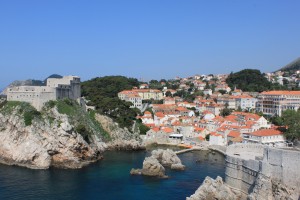The ‘Crown Jewel’ of the Adriatic and beyond
An intriguing and fascinating journey through the Balkans
Story and Photos by Michelle Lyn
When planning a trip to Europe, most people have the same places at the top of their list … Paris, London, Tuscany … the Balkans. Well, maybe not the latter. In fact, I don’t think you’re alone if you don’t know exactly where or what the Balkans are.
The Balkan region, often referred to as the Balkan Peninsula, is located in southeastern Europe. Greece is actually included in the area, along with Albania, Bosnia and Herzegovina, Bulgaria, Croatia, Macedonia, Montenegro and Serbia.
When my husband and I were trying to decide where to take our vacation this year, Croatia was at the top of our list. Several years ago, Dubrovnik was coined the “Crown Jewel” of the Adriatic, with many touting it as the “next” Greece. Wealthy Europeans had always enjoyed the Croatian coastal towns, but after the civil war in the early ’90s, the former Yugoslavia quickly became a sought-after vacation destination by many others.
With a favorable exchange rate, its crystal-clear aquamarine water, warm weather and proximity to hundreds of lush green islands, Dubrovnik served a warm welcome to glitz and glamour. The tourism industry took note and cruise ships began descending upon the port multiple times a day in peak season.
When I travel, I prefer a mix of the well-traveled spots, as well as the off-the-beaten path locations, so although Dubrovnik may be Europe’s worst kept secret, it remains a gem not to be missed.
Using Dubrovnik as our base to explore the Balkans, our trip began with a bus ride down the stunning Dalmatian coastline. The two-lane highway winds through a mix of hidden coves, beaches, fishing villages, red-tiled roofs and craggy mountains, all with spectacular views of the Adriatic Sea.
Upon arrival, a local city bus conveniently runs the 10-minute route between the port and bus station to Stari Grad, the fortified Old Town. We stayed at the Hilton Imperial Dubrovnik, a wonderful hotel that is ideally situated at the entrance to the picturesque Stari Grad, a UNESCO world heritage site.
To get your bearings, head straight for the Pile gate entrance to Stari Grad and take
a tour of the City Walls, one of the most famous and recognizable features of Old Town Dubrovnik. One of the most beautiful structures in the Mediterranean, the City Walls run uninterrupted for approximately 1,940 meters around the city. Up to 25 meters high, the system of turrets and towers was intended to protect the vulnerable city.
The two-hour walk gives a stunning perspective on the history of the town’s resilience, as evidenced in the pockmarks from mortar fire and homes with only foundations remaining from the not-so-distant days when the city was under seige. Contrastingly, you will also be in awe of the 360-degree views of the entire city and the beauty of the glittering sea.
If the weather is nice, take the time to find Bar Buza, a hole in the wall (literally) that opens up to a modest bar perched on the rocky cliffs with jaw-dropping views of the sea. Offerings are simple and with the Rat Pack serenading you, it’s nearly impossible to have a drink here and not feel like you are in a 1950s film set on a secluded Italian island.
After you’ve toured the City Walls, descend into the Placa, the main thoroughfare of the Old Town. The slippery, marble paved street stretches the short walk from the east gate to the west gate. Lined with restaurants, cafes, boutiques and tourist shops, the Placa is an excellent place to spend hours people watching or enjoying a gelato. Spend some time getting lost in the side streets, exploring the art galleries, chatting with locals and listening to evening concerts in the churches.
If there is one thing you must eat in Dubrovnik, it is seafood. It is fresh and abundant, served simply, yet deliciously. Locanda Peskarija is an excellent choice on the old harbor. Grilled calamari and seafood risotto served in cast iron pots do not disappoint.
Veltran, an incredibly helpful concierge at our hotel, arranged a car rental for us and helped us map out our trip to Montenegro, the next stop on our journey to explore the Balkans. One of the three former Yugoslav republics, Montenegro became its own country in 1996.
Ascending the cliffs above Dubrovnik, the sea quickly disappeared as the highway turned into a lush path though the rolling hills. In the small town of Gruda, Konavoski Dvozi came highly recommended for a traditional Croatian lunch.
Within half an hour, we crossed the Montenegro border with ease and continued back down the coast to our main destination, Kotor, located on the Bay of Kotor, the southernmost fjord in Europe.
Entering the bay, the incredible terrain took my breath away, while the serenity instantly reminded me of Lake Como, Italy. Lush, green mountains overlooked the occasional cropping of homes dotting the bay. A couple miles north of Kotor, we pulled over in a town called Perast, to look at the church on the islet called “Our Lady of the Rocks.”
According to local legend, the artificial island was created over the centuries by the seamen who found an icon of the Virgin Mary on a rock in the sea. The island was created by dropping rocks and sinking old ships loaded with rocks until the islet gradually emerged from the sea.
Pulling into the old Mediterranean port at Kotor, it became clear why it is also listed as a UNESCO world heritage site. One of the best preserved medieval old towns on the Adriatic, Kotor has been fortified since the early Middle Ages. Backed up against the hillside and overlooked by a looming castle, the Old Town is a maze of cafes, bars and shops.
Hotel Vardar was our hotel of choice and we found it easily once we entered the main square. Recently remodeled, it was surprisingly modern, with down bedding, plasma TVs and bathroom amenities akin to a Beverly Hills hotel room, without the Beverly Hills price tag.
Apart from hiking the 1,350 stairs up to Castle San Giovanni for a breathtaking view of the bay, there isn’t much to do in Kotor besides wander the streets until you find a nice plaza with a cafe where you can relax and take it all in.
The highlight of our stay was our dinner at Stari Mlini, a 16th century flour mill along the river Ljuta, that was converted into a charming restaurant. We were there during the shoulder season, so amazingly, we were the only ones at the restaurant that evening.
We arrived at dusk and wandered the property, taking pictures as the sunset left a soft orange glow. The river rushed down the mountain, through the mill wheel and slipped silently out to the bay.
The restaurant, a cozy stone house with wood beam ceilings was lit by candelabras and decorated with an eclectic mix of antiques. Sultry jazz filled the room with warmth, adding to its allure. It was obvious we had stumbled upon a local hidden gem, confirmed by the fact that our waiter was dressed in traditional clothing, yet thankfully spoke no English.
We ordered the house specialties: local cheese aged in marble jars of olive oil, a delectable local fish caught on the bay that morning and fileted tableside, a surprisingly delicious bottle of Vranac, the local red wine and plum brandy for dessert. Dinner at Stari Mlini was one of the most memorable dining experiences I’ve ever enjoyed and that alone was worth the 1 ½-hour drive from Dubrovnik.
Beyond Montenegro, our next destination was Bosnia and Herzegovina. This country garnered the most quizzical looks when I told family and friends where I was headed on vacation. Many Americans only know Bosnia and Herzegovina to be a war-torn country, not the next up-and-coming tourist destination.
Mostar, located two hours northeast of Dubrovnik, was our first destination. Crossing borders with only a cursory glance at our passports, the effortless drive into Bosnia and Herzegovina took us along the coast, into the mountains and through tunnels along the remarkably green Neretva river.
Mostar was named after “the bridge keepers” who kept the Stari Most (Old Bridge) safe. The symbol of Mostar, the bridge was built during the Ottoman era, but was destroyed in 1993 during the Bosnian War. In 2004 it was reconstructed and now serves as a major source of tourism for the country.
Despite a beautiful drive through the countryside, you are immediately reminded you are in a country that recently emerged from a devastating war as you drive through the city of Mostar. In the ’90s the city was attacked with artillery, mortars, heavy weapons and small arms that reduced much of the east side to rubble. Several buildings are still covered in pockmarks from the fierce shelling, many lacking walls and roofs.
Ironically, when you walk past the main streets, to the Old Bridge, you forget about it as you are drawn in to the peacefulness of the rushing river and tranquil atmosphere of the cafes and shops lining both sides of the bridge. Aware of this transformative effect, the locals etched “Don’t Forget” into many rocks lining the river and bridge as a reminder.
Many visitors choose to stay overnight in Mostar, but we opted to move on towards Sarajevo. That two-hour drive took us through more fields, winding up scenic mountain roads and eventually into the grim outskirts of a city with more of an Eastern European feel.
Antiquated cable cars, graffiti covered buildings and apartments that looked more like housing projects quickly gave way to a more modern, pulsating city as we drove towards the Baščaršija, the heart of Sarajevo’s Old Town.
I wasn’t quite sure what to expect in Sarajevo, so I was pleasantly surprised to find the modern City Boutique Hotel with a helpful receptionist who had, interestingly enough, just graduated from Cal State Long Beach. Go figure.
Upon her recommendations, we explored the easily walkable city, stopping at Brusa-Bezistan, the marketplace for silk and furniture, the Tunnel of Hope and The Latin Bridge, where archduke Franz Ferdinand and his wife were shot and killed, triggering the start of WWI.
Locals were very friendly and directed us towards the Sarajevo Brewery for dinner. We wandered above the river on the south bank, to a massive red and cream building with copper drainpipes.
We expected a young crowd at a loud bar, but were astonished by the elegance of the establishment. Apparently it is more of a destination for local politicians, and with dark wood and amber lighting, the multistory building felt more like an Ivy League library than a brewery.
People watching at a cafe along the popular Ferhadija Street, lined by modern boutiques and smoky bars filled with the trendy youth of Sarajevo was the perfect ending to my first journey through the Balkans .. .certainly not to be my last.


